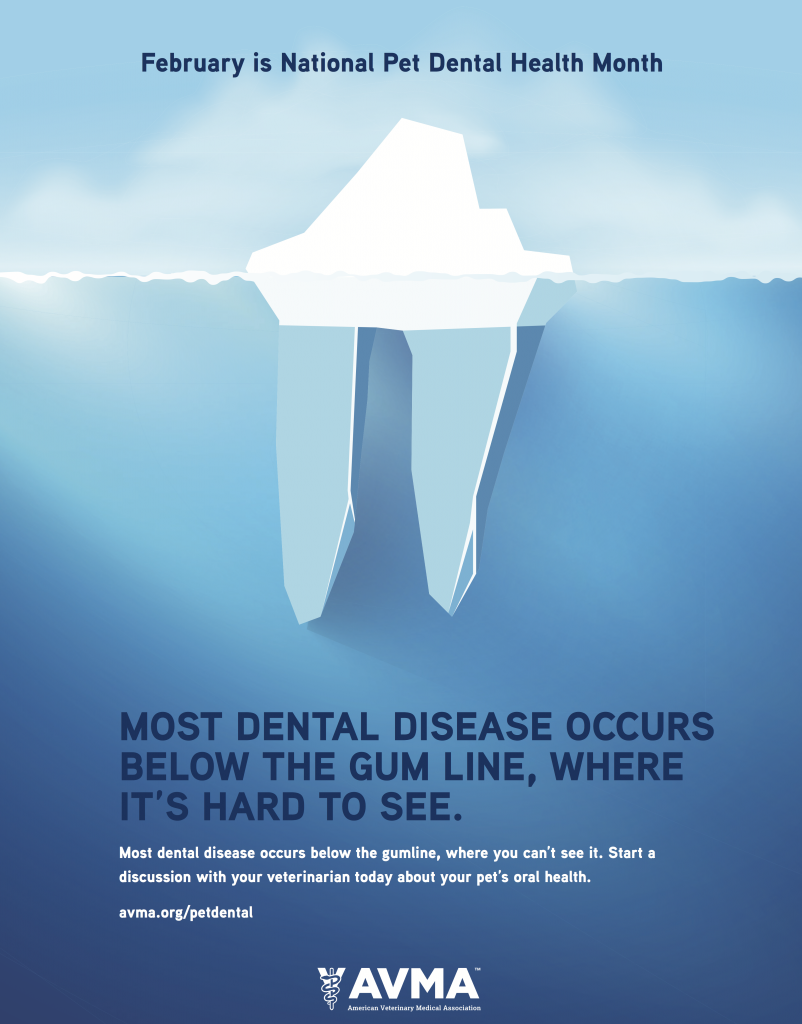Bad Breath, Bad Teeth, Bad Disease, Oh My!
By: Dr. Sarah Proctor, DVM
February is National Pet Dental Health Month! The month is sponsored by the American Veterinary Medical Association (AVMA) to bring awareness to the importance of oral care in pets. In this post, CVHS’s Veterinarian of Record, Dr. Sarah Proctor, DVM, discusses how to keep your pet’s mouth clean and healthy! Bonus: the better your pet’s oral health, the better their breath will smell!
Dental disease is the most common disease of dogs and cats. By age 3, 80% of dogs and 70% of cats have dental disease. So, what’s the big deal with a little bad breath?

First, oral bacteria cause plaque to form. That’s the yellow stuff you might see on your pet’s teeth, and the fuzzy stuff you feel on your own teeth if you forget to brush. If the plaque isn’t removed often, it hardens into a substance called tartar that can’t be brushed off. Bacteria under the tartar are then protected, and can burrow along the tooth root. As the bacteria get deeper, they break the tooth away from the jawbone and can also access the bloodstream. This whole process is called periodontal disease, and causes teeth to become loose, painful, and infected. In advanced cases pets can have missing teeth and even broken jaws. Bacteria entering the bloodstream can damage vital organs like the kidneys and heart. To make things even worse, pets often don’t show signs of dental pain. Obvious signs like pawing at the mouth, drooling, or not eating are not common. Many pets act and eat normally with very painful teeth.
You can prevent periodontal disease in your pet with daily brushing. Most people fail in brushing because they rush the process.
How to successfully brush your pet’s teeth:
- Have your vet examine your pet’s teeth. If they have bad dental disease, brushing may be painful. Your pet may need a professional cleaning first so that any painful areas can be addressed. Once your vet gives the ok, you can start!
- Get pet toothpaste – made specially for pets so it doesn’t get foamy, is safe to swallow, and has a pet-friendly flavor.
- Get a toothbrush – any kind will work but infant finger brushes are nice and soft. Long handled pet brushes are nice for dogs with long snouts.
- Offer your pet toothpaste on your finger. Make sure they like it! Do this for a few days.
- Put toothpaste on the toothbrush and offer your pet the paste off the brush. Do this for another few days.
- Put paste on the brush and place it on your pet’s top front teeth. You may lift their upper lip so you can see what you’re doing. If they tolerate this, try brushing back and forth a little. Let them lick as you go and don’t worry about actually brushing much. Do this for a few days.

- As days pass and your pets tolerates brushing of the front teeth, try to move towards the side day by day until eventually you can brush the fronts, the sides, and all the way to the back of top and bottom teeth. The key is not to move further along until your pet is comfortable with each step. Be patient.
- You don’t need to brush the inside surfaces of the teeth in most pets. If you can keep the outsides of the teeth clean, the insides will likely stay clean too.
- Brushing once daily is the ideal, but your pet can still benefit from brushing 2-3 times per week. Aim for 30-60 seconds of brushing each day, but some is better than none!
Other solutions (like dental treats, water additives, chew toys, etc.) don’t work as well as brushing. Without brushing, some pets will need veterinary cleanings periodically to keep their mouths healthy and comfortable.
Keep in mind that there are other tooth problems that can’t be prevented by brushing. Be sure to get your vet’s recommendation before starting a brushing routine. February is Pet Dental Health Month and is a good time to get a consultation. Many vets offer discounted dental screenings or cleanings in February to promote dental health.
For more information on pet dental care (including videos and a self-quiz) visit the AVMA website.
